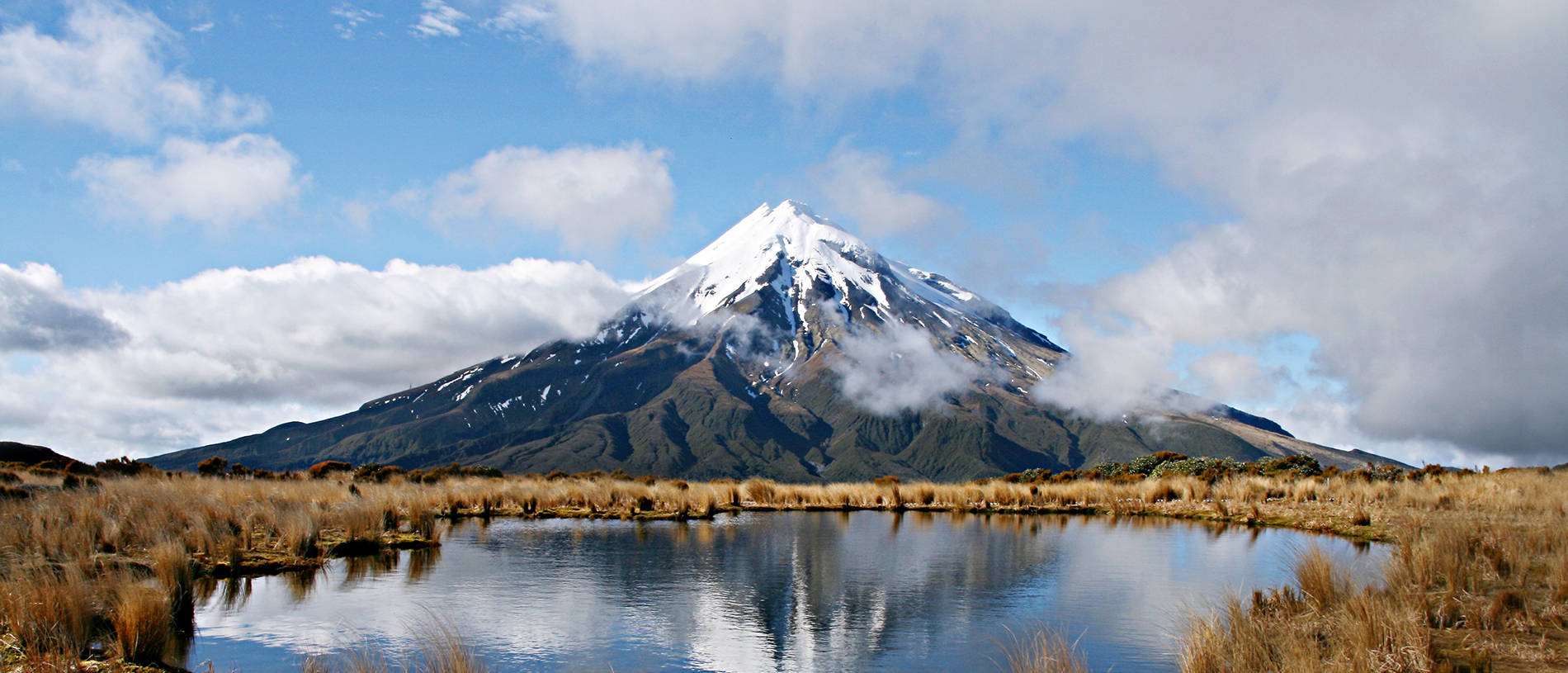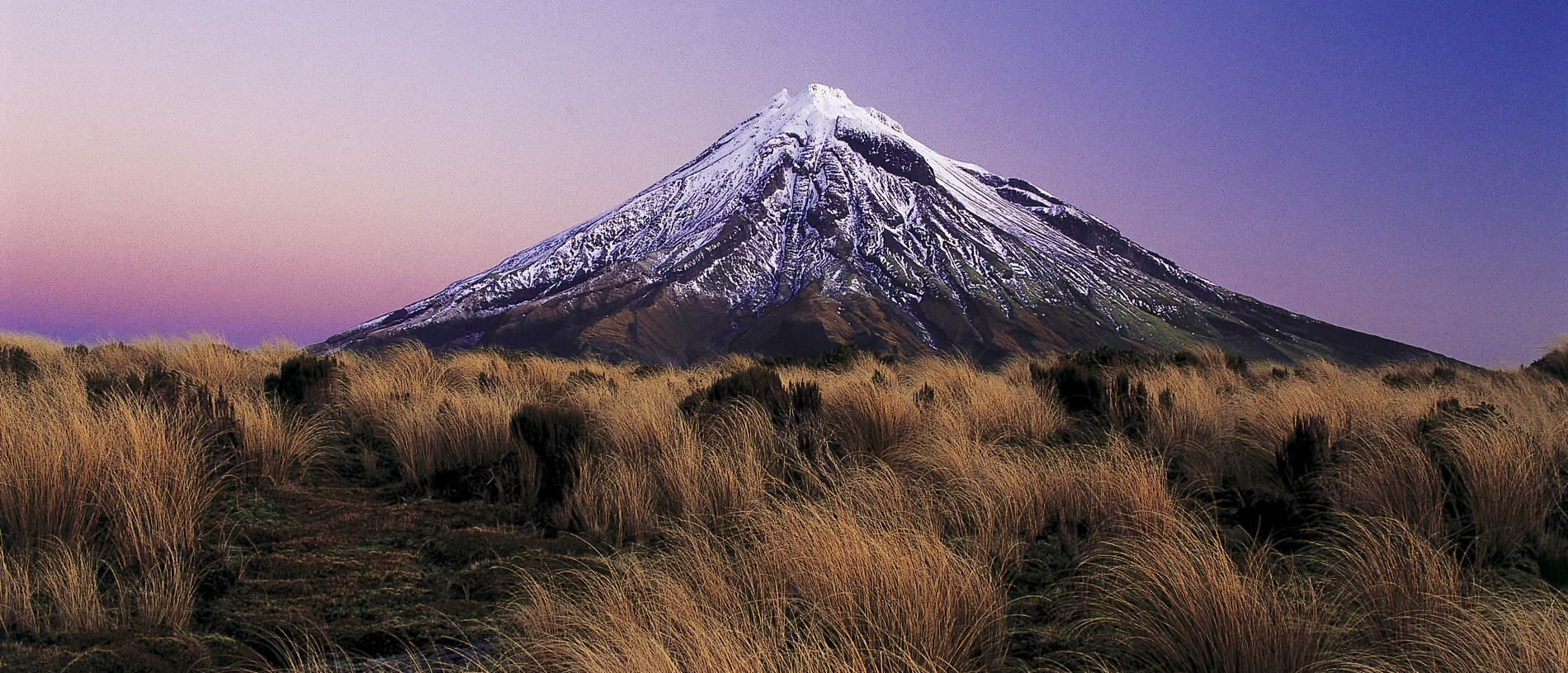
Mount Taranaki: picture-perfect peak
Taranaki is about as close as you can get to the ideal of volcanic beauty – almost perfectly round, its nearly symmetrical cone rising to a pointed summit, with a single crater.

Taranaki’s catchphrase, that it is 'like no other' – is, at first glance, nonsensical: after all, no place is quite like any other. But let’s see...
While the region can suffer summer dry spells, especially around the coast, they rarely last long. Visitors count themselves lucky to see the iconic peak of Mount Taranaki in its full glory and leave disappointed when it’s shrouded in cloud for the duration of their stay.
That Taranaki is a place apart is certainly true. Its land link to the outside world is a single major road, SH3, a winding but scenic trip through those northern hills from the Waikato and along the coast to the region’s largest and only city, New Plymouth. The highway then travels east of the mountain through small rural town after small rural town.
Until a rough carriage track was hacked over Mt Messenger in the late 1890s, Māori and European alike trekked along beaches at low tide or braved forest trails. Even today, when a new stretch of expensive highway is about to be constructed over the Messenger range, this route remains challenging.
The only other road access into the region is SH43, a slow excursion along the Forgotten World Highway from the central plateau. Its historic and scenic attractions help compensate for the narrow road, full of twists and turns, which remains partially unsealed to this day. This trip is not complete without a stop at the small settlement of Whangamōmona: every two years the remote district declares itself a republic and thousands flock to catch eels, skin possums, throw gumboots, elect a new president, eat and drink too much and have a rollicking good time.
To the west, Taranaki is pounded by the turbulent Tasman.
The long shoreline is renowned for its iron sand beaches, black and hop-hop scorching in summer. The surf is always pumping and it's no accident that the 105-kilometre coast road between Hāwera and New Plymouth is also dubbed Surf Highway 45.
Even if you’re not into riding waves, its worth an around-the-mountain circuit to see the eroding cliffs, rocky headlands, cape lighthouse and those magnificent beaches. You might also cast an eye over Taranaki’s marine reserves, Tapuae and Paraninihi, as well as the marine park around the Sugar Loaf Islands. And always, of course, there’s that mountain at your back, constantly, subtly, changing at every turn.
The mountain, Taranaki, or Egmont, as Cook called it and it is alternatively known, is at the heart of everything. A classic cone, 2,518 metres high and white-capped for much of the year, it sits proud, like a bird smack in the middle of a nest of its own making. It’s a more correctly a volcano, the youngest in a line that begins with New Plymouth’s Sugar Loaf islands then moves south through the Kaitake and Pouākai Ranges. The older volcanoes are extinct but Taranaki has been active for the last 120,000 years, explosively blowing its top approximately every 340 years with smaller snorts at intervals between (the last in 1755). It is likely to stage a repeat performance again someday and deliver another helping of lava, ash and volcanic debris to the countryside.
When the first humans arrived, the whole region, from coast to mountain slope, was cloaked in trees.
The region’s volcanic past and its isolation had created a unique botany, with beech species notably absent. Like elsewhere in New Zealand, the forest rang with birdsong. But ultimately, much of that forest was felled and burned. Trees were replaced by open countryside and the pasture that today underpins Taranaki’s massively successful dairy industry. Fortunately, forest fragments on the ring plain, in the eastern hills and the great island of trees in the 33,500-hectare Egmont National Park were spared.
Today, conservation efforts mean cattle and sheep are being fenced out of the 300-plus waterways that radiate from the mountain; river banks are being replanted, creating shade for the waters, filtering land run-off and becoming wildlife corridors that link existing forest areas and connect the park to the sea. Even better, the Taranaki Mounga Project, started in 2016, will ultimately eliminate those pesky introduced animals and plants, and when that’s done long-absent native species will be returned and those whose populations are just hanging on, will rebound.
For a preview, visit one of the sanctuaries, especially the beautiful predator-free Rotokare Scenic Reserve Trust in South Taranaki, the Pūrangi Kiwi East Taranaki Environment Trust or Tiaki Te Mauri o Parininihi Trust.
If walking, tramping or climbing is your bag then, again, you can’t go past the mountain and the ranges. There are a number of road entrances to the park and something for everyone, from easy ambles through the Goblin Forest to longer hikes such as the popular Pouākai track, or climbs above the bush line, including to the peak itself (but please, ensure you are fit and prepared because conditions can deteriorate without warning).
The mountain offers a brief ski season in winter and you can even take to the skies and helicopter, fly, or glide over it.
The rest of the region offers equally awesome outdoor experiences, from the coastal walkway and beaches to spots such as Lake Mangamāhoe where walking, cycling and horse-riding trails take you around the chocolate-box scenic lake – reflecting, you guessed it, the mountain.
The green-fingered will revel in the region’s public and private parks and gardens especially in spring during the garden festivals. These include Pukeiti and Hollards, not far from the national park, while New Plymouth has Tupare, an exceptional historic garden, the excellent Pukekura Park and adjoining Brooklands Bowl as well as umpteen smaller parks and gardens.
Wherever you go, you are steeped in history because, of course, Taranaki is famous – or infamous – for its bloody past.
In pre-European times Māori built many defensive fortified pā especially around the coast, their outlines still visible in varying degrees in the countryside today.
Whaling and sealing, the land wars of the 1860s, the decades and struggles of land clearance, the wars of the twentieth century and the stories of the daily lives, sorrows and joys of ordinary men, women and children are there to discover in the region’s pā sites, small towns, churches, memorials and cemeteries.
Must-sees are Puke Ariki Museum in New Plymouth and Tawhiti Museum not far from Eltham. Consider also, a rail tour through east Taranaki, along disused lines, through tunnels, over bridges and through small country communities.
With so many outdoor attractions, it would be easy to overlook the finer things of life: art, music, theatre, dining out. Taranaki’s cultural stand-out has to be the internationally renowned Govett Brewster Art Gallery, proud holder of the Len Lye art collection and site of sculptures such as the Wind Wand on the walkway.
New Plymouth’s TSB Showplace theatre also guarantees first-class dramatic and musical productions. The region is well served by breweries and wineries, many with excellent cafés and restaurants in beautiful settings, beside the water, overlooking the sea, in gardens, gazing up at the mountain.
And so it ends, as it began, with that mountain. Even when you’re not consciously aware of it, it’s there at every turn, a defining presence signifying home. Returning locals have been known to wipe away a tear when they first sight its familiar form across the ocean at Mōkau or on the skyline just north of Whanganui. Perhaps, after all, the slogan-writers are not so silly: Taranaki is not just a world apart; it really is like no other!